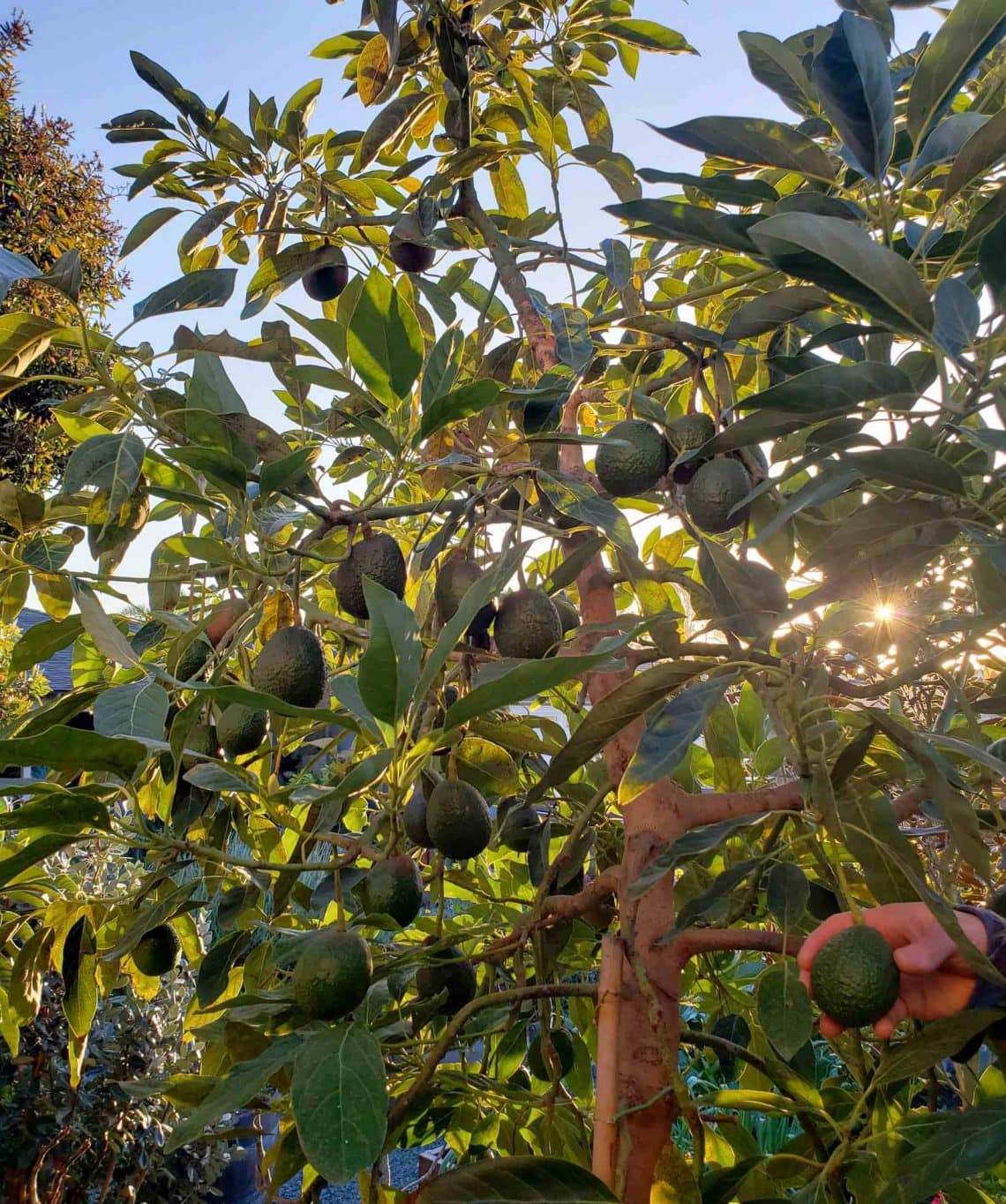
How to Grow Avocados: Tree Varieties, Climate, Planting & Care
Imagine a big beautiful evergreen tree, bathed in sunshine and dripping with avocados. Now imagine that tree in your very own yard – providing you with fresh, creamy homegrown avocados. Guacamole. Avocado Toast. Salads. Avocado on everything! That is the stuff that garden dreams are made of, am I right?! I wanted to plant an avocado as soon as we had our own property. Now, we have three healthy avocado trees – and two that are already producing fruit. We are incredibly fortunate, because as much as I hate to say it… most climates are not well-suited to grow avocados.
Read along to learn how to grow avocado trees at home. First, explore some popular varieties, tree cross-pollination considerations, and whether to grow avocados from a pit or a nursery tree. Then we’ll go over the ideal climate and conditions needed to successfully grow avocados, how to plant avocado trees, common pests, and tips on growing avocados in containers as well. Last but not least, learn how to tell when it is time to harvest ripe avocados, and exactly how to do so!
Origin of Avocados
Wild avocado trees are originally native to south-central Mexico, growing there as long ago as 7000 BC. Hass, the most popular and in-demand commercial avocado variety to date, was first bred in a Southern California backyard in the 1930s. However, the Hass wasn’t grown and marketed on a large scale until the late 1970s. Today, the majority of the world’s avocado supply is cultivated between Mexico, Chile, and Central to Southern California. This should give you a pretty good idea of the type of climate they like!
If you’d like to learn more about the history (and controversy!) of avocados, I highly suggest watching “The Avocado War” episode on the Netflix series ‘Rotten’. Let’s just say it makes me even more grateful to grow our own.
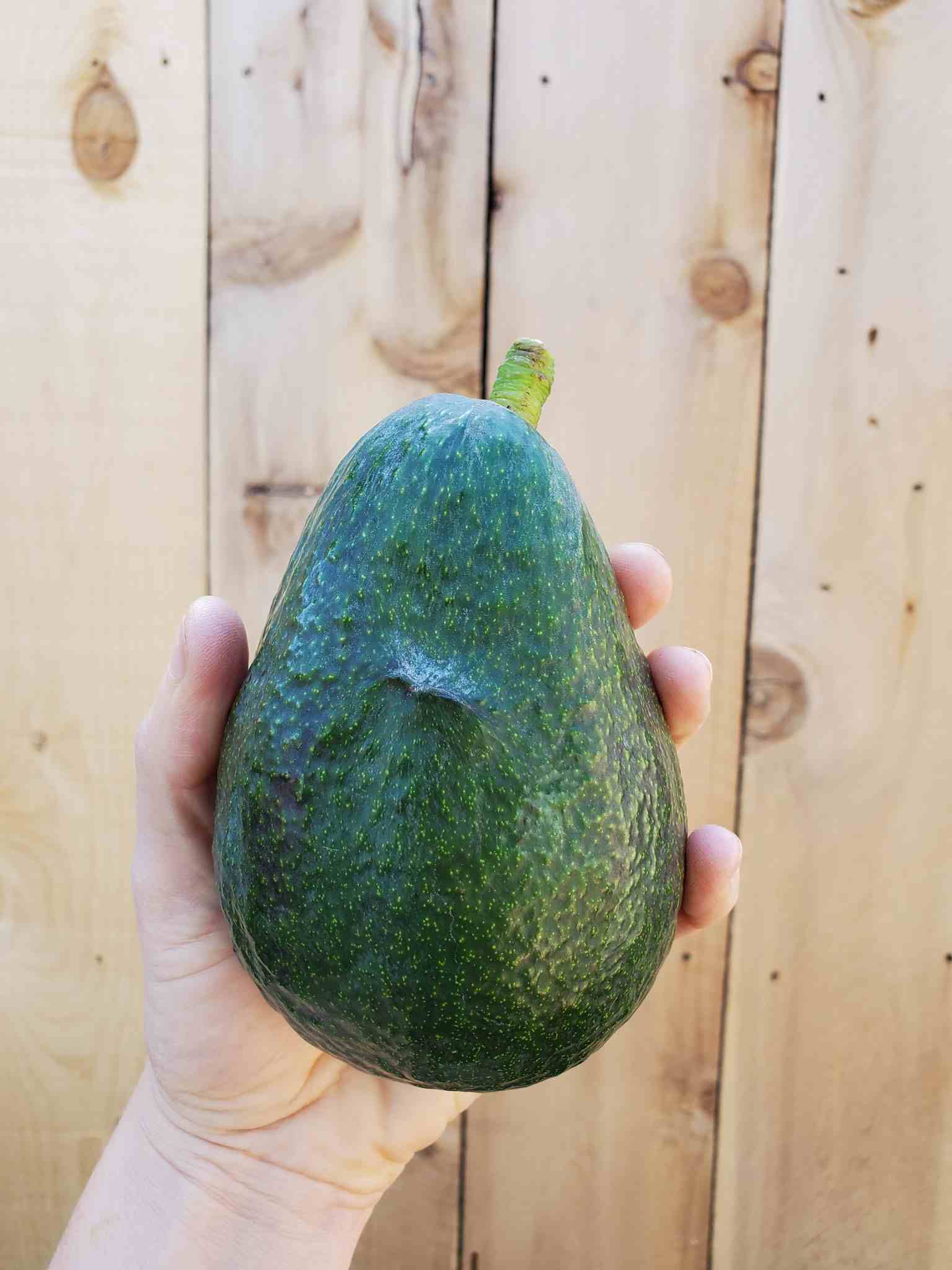
GROWING AVOCADOS: GETTING STARTED
Avocado Tree Varieties
You’re likely familiar with Hass avocados – the ones you’ll find in every grocery store. But chances are, many of you haven’t had the opportunity to sample other types! Heck, maybe you’re not even aware that there are literally dozens of different varieties of avocados out there. Most of them don’t make it to market because they’re too fragile for commercial shipping and processing, but they’re fabulous to grow at home. Before we dive into all of the varieties of avocados to grow, let’s talk about them in terms of two larger groups first: Type A and Type B avocados.
Type A vs Type B Avocados & Cross-Pollination
Every variety of avocado falls into either the Type A or Type B category. For example, Hass is a Type A and Fuerte is a Type B. To encourage optimal fruit development, it is best if both a type A and type B avocado tree are planted close by. I won’t dive into the nitty-gritty on their differences in detail here, but in a nutshell: Type A avocado female flower parts open at the same time as Type B male flower parts, and vice versa. This more than doubles the chance of successful pollination and fruit-set! Avocado pollination is primarily accomplished by bees, and less so by wind.
While ideal, it is not absolutely necessary to have one of each type. Most avocados varieties are considered “self-fruitful” and therefore do not need a partner tree for cross-pollination. Even without a friend, they should develop some avocado fruit. Hass and Reed are particularly good at providing a decent crop when grown solo. On the other hand, having that opposite Type A or Type B partner tree around basically guarantees a much larger and more successful crop. Certain varieties are especially dependent on a partner tree, such as Pinkertons.
Now, this could mean that you grow two different avocado trees in your yard. If you have space to do so, more avocados sounds like a win-win to me! Yet if you don’t have the space, other avocado trees in your neighborhood may be sufficient to provide cross-pollination to your tree. How close do avocado cross pollinator trees need to be? Some internet sources say within 25 to 30 feet. Yet others say within a few neighborhood blocks. Essentially, if avocado trees are common in your area, you should be just fine with one.
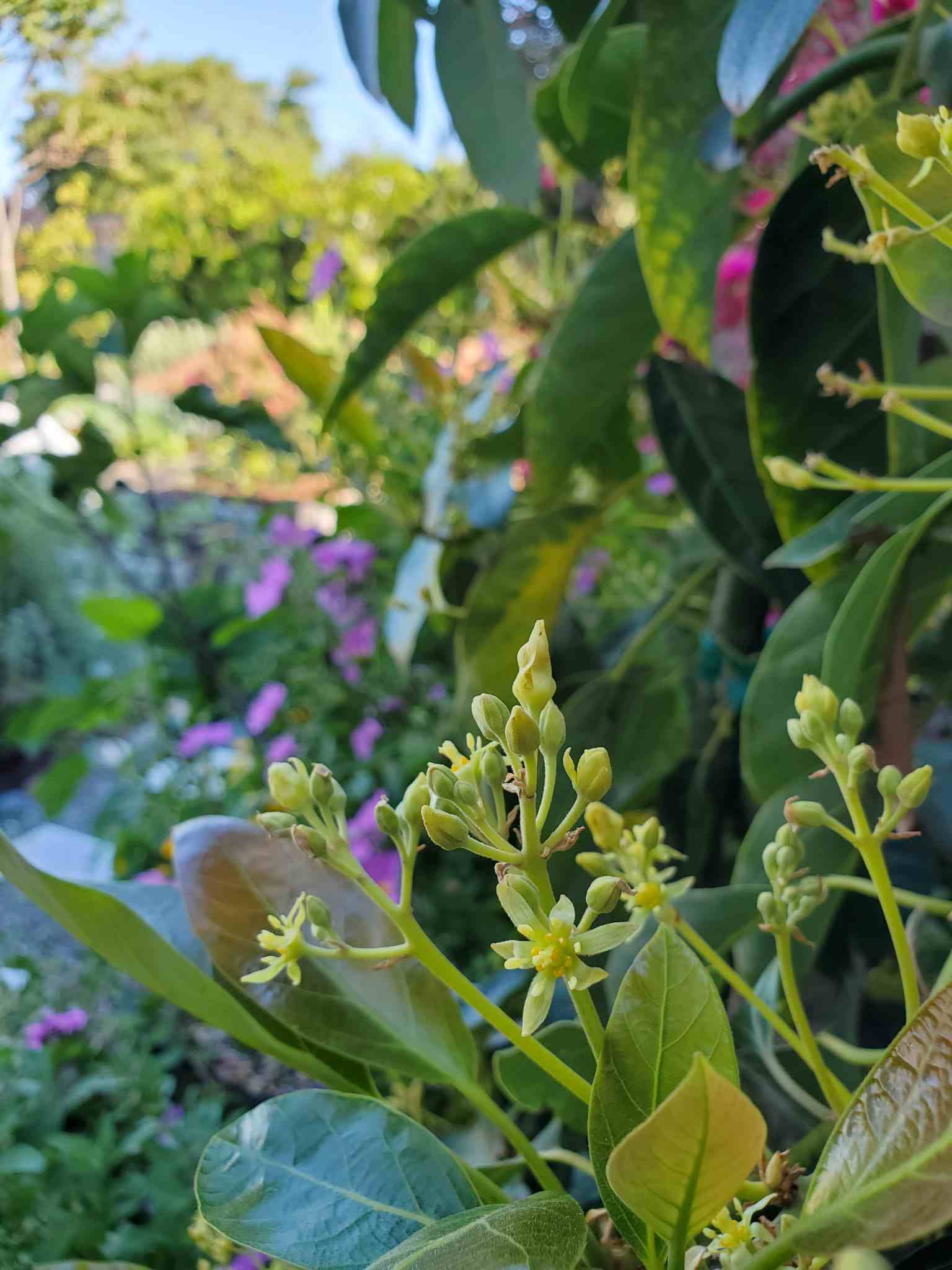
Popular Avocado Plant Varieties
Below is a list of some of the more popular and easy-to-acquire avocado tree varieties, separated by type A or type B. Keep in mind that there are still dozens of other boutique, speciality, or otherwise rare cultivars out there as well! Different avocado types vary in tree size, maturation/fruiting time, skin, flavor, and tolerance to cold and heat.
Instead of describing every avocado variety in detail here, I decided to save that for a separate post. Check out our “20 Awesome Avocado Varieties” article to learn the growing habits, tree size, hardiness zones, and fruit characteristics of 20 different avocado varieties to choose from!
Curious what types of avocados we grow? Our largest, oldest, and most productive avocado tree is a Hass. We also have one Fuerte and one Sir Prize avocado tree each in our garden to serve as cross-pollinators for the Hass.
Type A Avocados
Type A avocado varieties include: Hass, Pinterton, Lamb Hass, Carmen Hass, Gwen, Reed, Mexicola, Stewart, and Holiday. Of them all, Hass and Reed are the most common. Reed avocados grow huge and round like a softball, are delicious, and require less water than Hass – a real perk in drought-ridden California! Mexicola is the most cold-hardy of these Type A’s. I’d love to plant a Gwen avocado in our next garden (we’re maxed out here!), described as equally nutty and buttery as Hass, but with larger fruit on a smaller tree. Truthfully, I want to grow these all!
Type B Avocados
Type B avocado varieties include: Fuerte, Bacon, Zutano, and Sir Prize (along with Whitshell, which is finicky and grows best in commercial greenhouses). Fuerte is the most popular “B” type avocado, often grown in commercial orchards alongside Hass for pollination. Some people consider Type B avocados inferior to Type A because their flesh is prone to being more watery, while Type A’s are richer in flavor, oil, and fat content. One exception is the Sir Prize. As a descendant from Hass, Sir Prize is very similar in texture and flavor, but grows larger fruit with a smaller pit! In fact, Sir Prize is said to have the largest flesh-to-pit ratio of all the commercial avocado varieties.
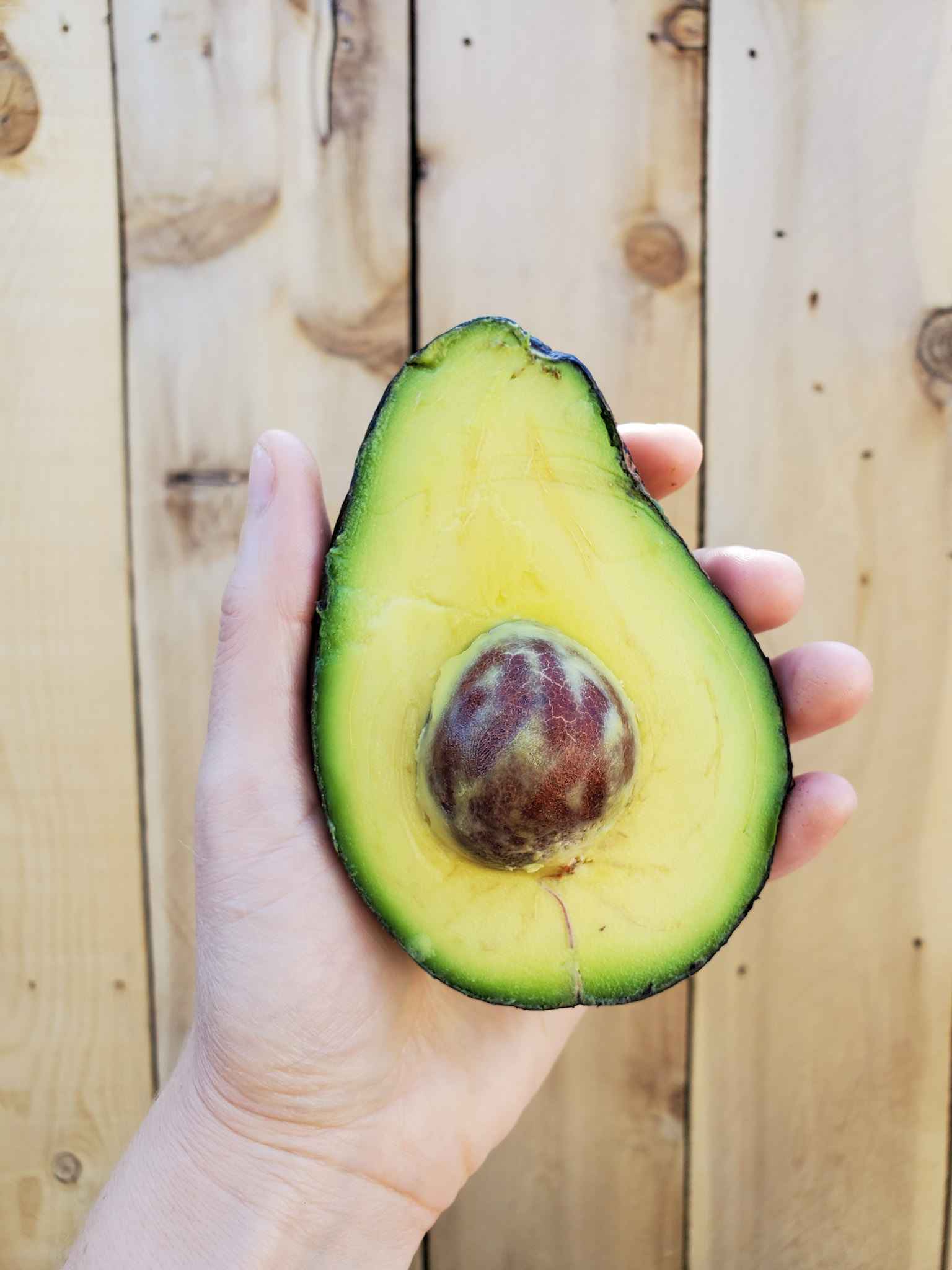
Both Type A & B
There is one special variety of avocado plant that has both type A and type B flowers at once. The Wurtz or “ Little Cado” is also the only true dwarf avocado variety. Between its compact size, superior self-fertility, and ability to bear fruit sooner than most – the Little Cado is awesome for backyard gardens and small spaces. It only grows to about 10 to 15 feet tall maximum, whereas other avocado varieties can grow up to 80 feet tall! It is the best variety choice to grow in a container, such as a half wine barrel or other suitable large pot. Don’t worry, we’ll talk more about growing avocados in containers soon.
The Most Cold-Tolerant Avocados Plant Varieties*
- Mexicola Grande: (type A) cold-hardy to 18 to 20°F (one of the most tolerant of extended periods of cold)
- Fantastic aka Pryor: (type A) cold-hardy down to 15°F
- Bacon: (type B) cold-hardy to about 20-22°F
- Joey: (type B) cold-hardy down to 15-18°F
- Opal aka Lila: (type A) hardy down to 15°F for brief periods but otherwise 22-25°F
- Brogdon: (type B) cold-hardy down to 24°F
- Winter Mexican: (type B) tolerant of routine temperatures in the mid to low 20’s
- Wilma aka Brazos Belle: (type B) cold-hardy down to 15-18°F, does well in drier climates with less humidity
- Fuerte: (type B) cold-hardy to 30°F
*Avocado trees are most tolerant of the cold temperatures listed above once they are mature and established, or 3-5 years old. Young trees will require additional protection.
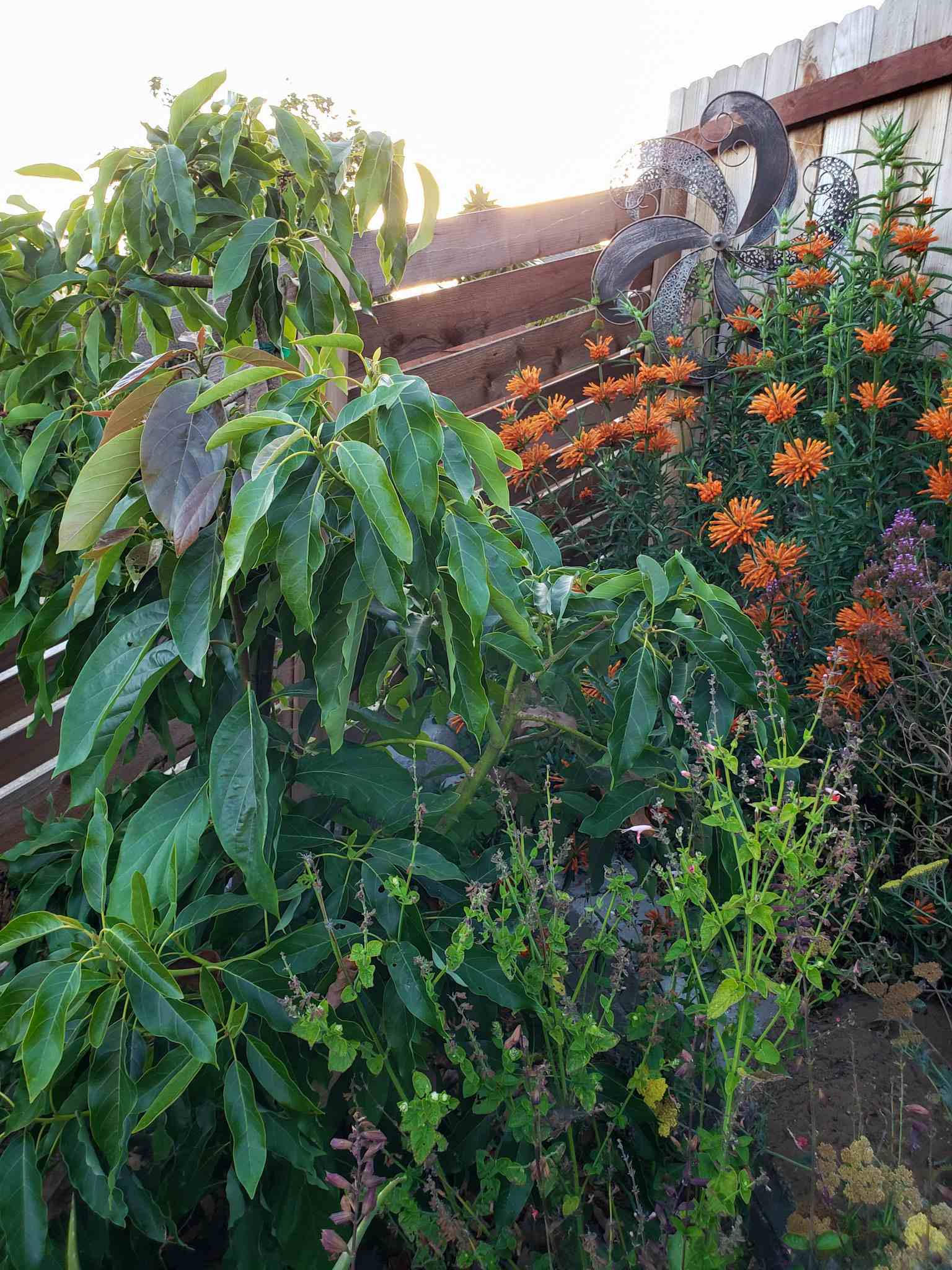
Growing Avocados from a Pit vs a Nursery Tree
You’ve all seen the image: an avocado pit, stuck with a few toothpicks, propped up and half-submerged in a glass of water, starting to sprout. Boom, a baby avocado tree is born! It seems so easy and cheap to grow an avocado from a pit, but I will be blunt here: I advise against it. Why? A number of reasons.
Time
First of all, growing an avocado tree from a pit will take forever. Literally. You may not even live in your home anymore by the time the dang thing fruits! An avocado tree grown from a pit can take 10 to 15 years to bear fruit. On the other hand, you can expect to be harvesting your first home grown avocados from a nursery tree within the first few years – depending on the size, variety, and age of the tree you purchase. Most nursery-grown avocado trees bear fruit by the time they reach 3 to 4 years old. Our Hass is about 4 or 5 years old, and totally chock-full of fruit this year!
Quality
Second, even if you have the time and patience to wait for your pit-grown avocado tree to produce fruit – the fruit itself may be disappointing! Avocados do not reproduce true to seed, or “breed true”. This means that the avocados that eventually grow will not be the same type or quality as the pit they were grown from. Commercial and nursery avocado trees are not grown from seed or pits. Instead, growers graft cuttings onto rootstock. The rootstock is another bonus of growing avocados from nursery trees: growers use healthy and disease-resistance rootstock, which sets your young tree up for success.
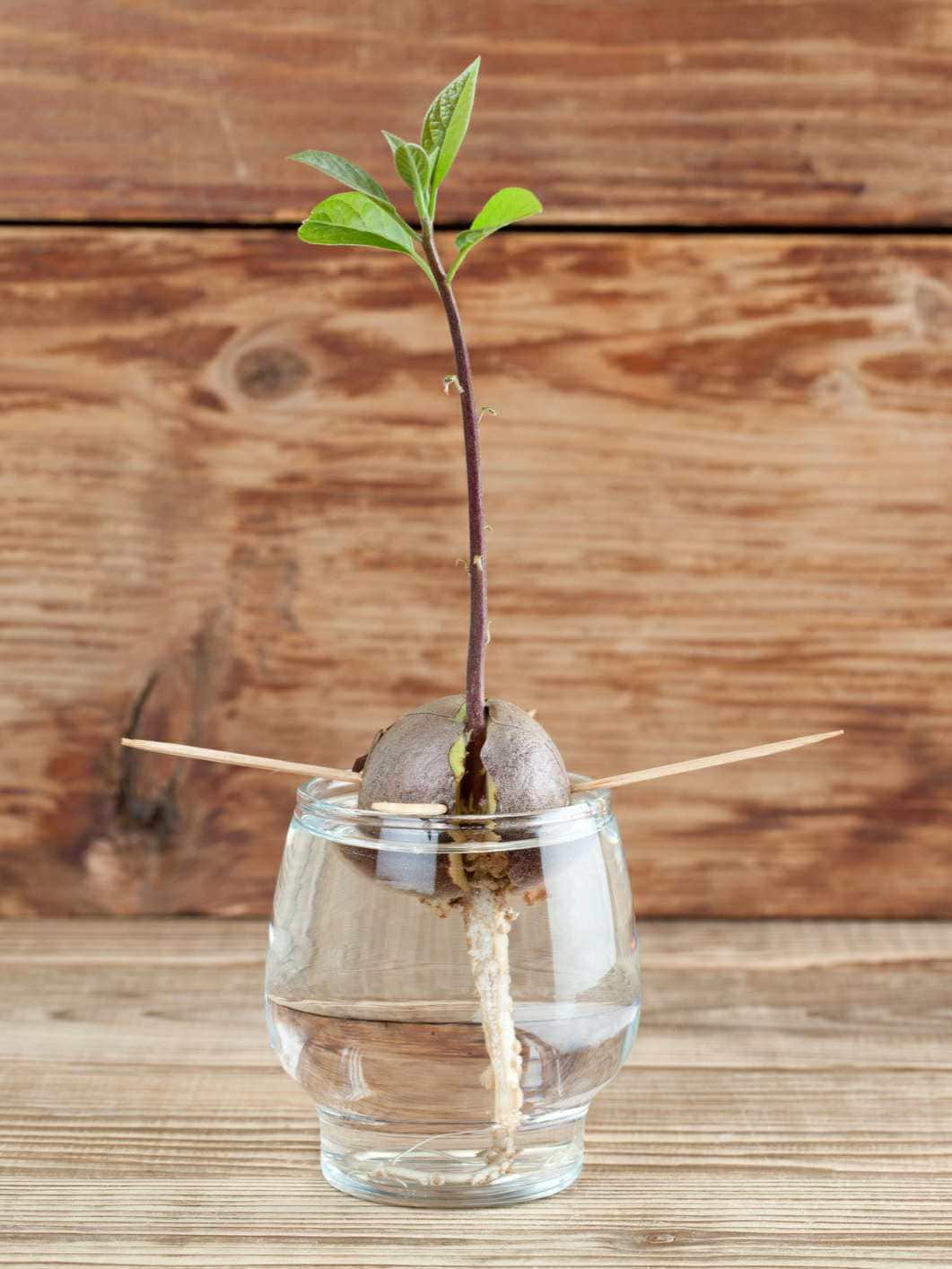
Considering all of this, purchasing a small established avocado tree from the nursery is an extremely worthwhile investment. You can purchase avocado trees in 5, 15 or even 25 gallon pots and up. We bought all of our avocado trees in 15-gallon containers, likely two or three years old already. That said, sprouting an avocado plant from a pit is definitely fun. The kids love it! I don’t want to dissuade you from enjoying a neat experiment, but want you to have realistic expectations too.
Where to Buy Avocado Trees
In addition to growing a healthier and more productive tree, you’ll be able to choose from a significantly wider selection of varieties at the garden center than growing from pits! Visit your local nursery and have a look around. If they don’t currently carry what you’re hoping for, ask to see if they can place a special order for you. We do that all the time!
Another option is to order avocado trees online. Two great options include Nature Hills Nursery and Fast Growing Trees. They both offer several varieties of avocados. Keep in mind trees purchased online will likely be far smaller than what you could get in-person though.
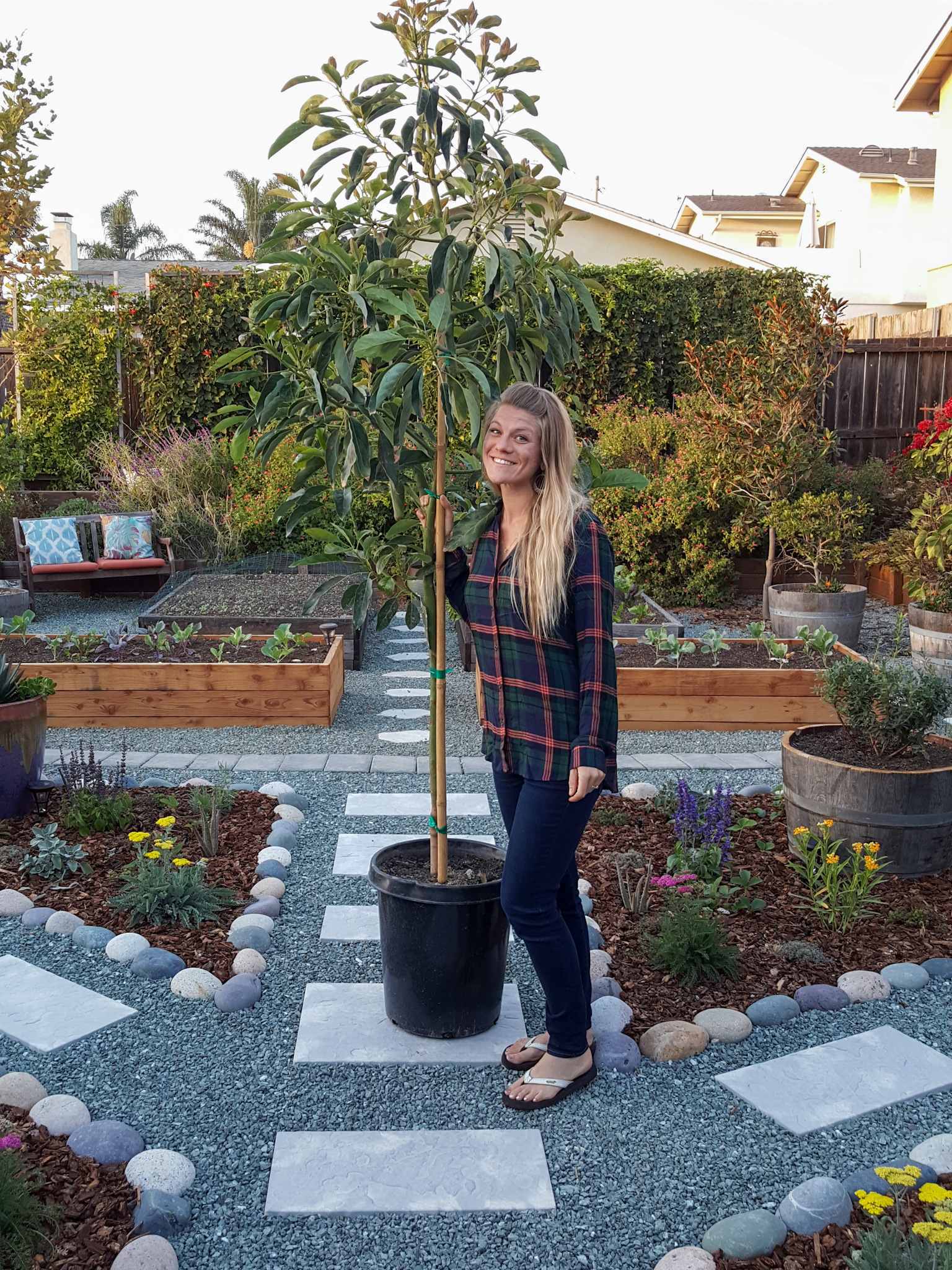
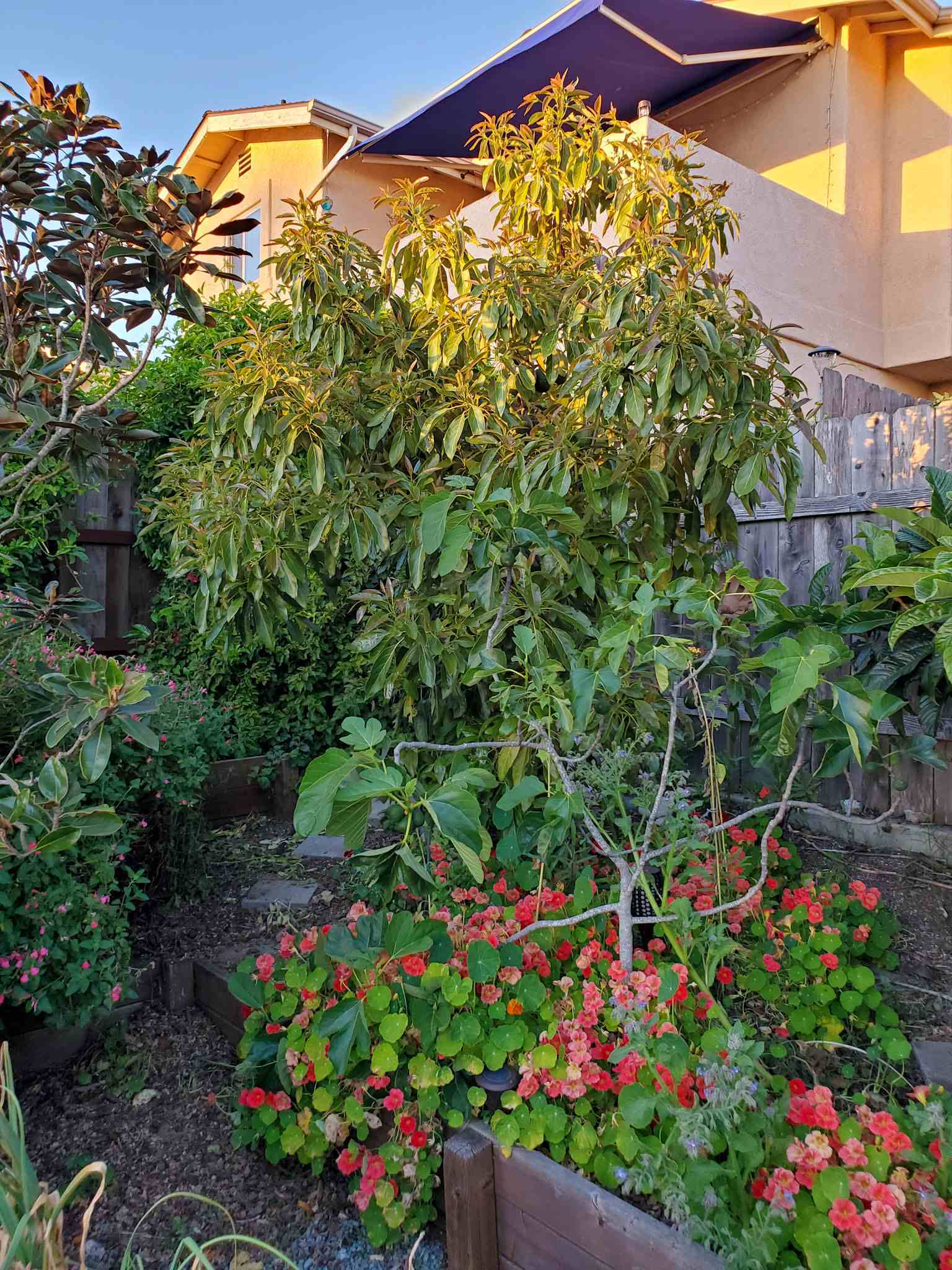
Now that we’ve explored the various types of avocados, let’s talk about how to actually grow them!
AVOCADO GROWING REQUIREMENTS
Avocados need a long growing season in a warm, frost-free environment with moderate humidity. Gardeners who live in California, Florida, Hawaii, the deep South of Texas, or other similar temperate subtropical locations will have the most success at growing avocados. Keep reading to learn about their preferred temperature ranges (including how to push the limits), soil, fertilizer, water, mulch, and planting instructions. Also, tips on growing avocado trees in containers and bringing them indoors!
Temperature
Avocados grow best in mildly warm conditions: not too hot, nor too cold. The ideal temperature range is an average of 60 to 85 degrees Fahrenheit.
Heat
One may imagine that avocado trees love heat, given where they originate! Yet that isn’t completely true. In Mexico and South America, most avocado trees grow at higher elevations that keep them protected from the sweltering temperatures of the valleys and lowlands below. An avocado plant has pores in its leaves called stomata, which help the tree both photosynthesize and respire. Apparently, in temperatures over 90°F, the stomata begin to close and cause stress for the tree. Fruit and flower drop is likely to occur at temperatures over 100°F. Damage will vary depending on the age, hydration, and variety of the tree – but overall, high heat can cause damage to leaves, fruit, and overall tree health. Established avocado trees can grow in excessively hot and arid climates but are less likely to bear fruit.
Mexican and Mexican-hybrid avocados appear to be the most heat-tolerant varieties, including Mexicola, Reed, and Lamb Hass. The more common Hass and Fuerte are some of the least heat-tolerant. During an occasional heatwave, avocado trees can be protected with shade cloth. Extra irrigation also helps, including above-ground sprinkling/spraying to cool the air and increase humidity levels under the tree canopy.
In our garden, excess heat is not an issue – so I am not an authority on the subject! To learn more about protecting your avocado plant from heat, see this great article from avo expert Greg Alder at the Yard Posts. He has some great examples about measures to take to grow avocados in hotter inland California areas.
Cold
Once established, some avocado trees can tolerate occasional freezing temperatures in the high 20s to low 30s with minimal damage. The level of cold-tolerance varies between different varieties of avocados. Mexican varieties are the most cold-hardy, including Mexicola Grande (hardy down to 18°F) and Mexican hybrids like Bacon and Fuerte (both frost-tolerant down to about 26°F). Hass, a Mexican-Guatemalan hybrid, is sensitive to temperatures below 30°F- as are with many other Guatemalan types. The third and final “race” of avocado types are West Indian varieties, who are not tolerant of any frost at all.
In general, avocados do not like extended freezing temperatures. If it doesn’t kill them, it will negatively impact their fruit development. Protecting young trees with frost blankets on exceptionally cold nights will help them survive. An especially deep layer of mulch around the base of the tree can also help protect tree roots from freezing in the event of a cold snap.
If you think your climate is too cold to grow avocados, read the “pushing the limits” to follow. And if you still decide it simply isn’t possible (or worth the effort) – consider growing another kind of fruit tree! Cold temperatures are actually desirable for many fruit trees, including apples, pears, and stone fruit like apricots and peaches. Unlike an avocado plant, they all need a minimum number of “chill hours” to bear fruit. Learn more about other cold-hardy fruit trees here.
USDA hardiness zones that can grow avocados
Avocados are generally grown within zones 8 through 11, but that doesn’t mean that every garden located in zone 8 through 11 is suited to grow avocados! That is, without some extra care and modifications at least. I intentionally covered avocado temperature requirements before zones, because conditions within the same hardiness zones can vary so drastically. The USDA hardiness zones are mostly based around common frost dates. On the other hand, they do not take into account high temperatures, humidity, precipitation, or other factors.
Take our zone 9b/10a for example. We are located on the Central Coast of California, yet areas of Florida are also considered 9b/10a! While neither of us gets much in the way of frost, our summer high temperatures and humidity levels couldn’t be more different. In our particular temperate microclimate, it rarely gets over 80°F.
Avocados grow and set fruit best in climates with medium-high humidity. The ideal relative humidity range for the majority of avocado varieties is between 45 to 65%, give or take 5%. Just as in extremely hot conditions, very dry air also causes avocado leaf stomata to reduce function for optimal tree health and fruit set. Here on the Central Coast of California, we are on the lower end of the spectrum, averaging around 30 to 50% – and they’re growing quite well!
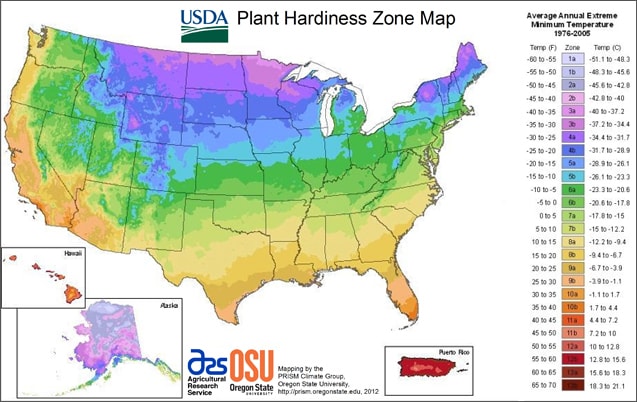
Pushing the limits with microclimates (& dedication)
Now that you know more about what type of growing conditions avocado trees prefer, do you think you can provide that for them? Even if it doesn’t seem like avocados will readily and easily grow in your area – don’t give up hope on that homegrown guac! If you are living right on the edge, perhaps there are some modifications and measures you can take to attempt to grow avocados at home, despite the odds.
For instance, does your area occasionally see temperatures around 20°F in the winter, but rarely colder than that? You may be able to grow avocados if you are dedicated, and smart about selecting the right variety and planting location. As previously mentioned, supply an extra-deep layer of mulch and be prepared to cover young trees with frost blankets as needed.
Another way to protect avocado trees from chilly conditions is to create a microclimate within your garden. Choose a sheltered planting location rather than an exposed one. If you live in the northern hemisphere, planting an avocado tree near a south-facing wall will provide radiant heat for the tree – and warm the soil 5 to 10 degrees over other locations in your yard. In some instances, this can bump up that particular spot by an entire USDA hardiness zone! Similarly, choosing a planting location that is shielded from the hottest afternoon summer sun can help reduce stress to the tree if excessive heat is an issue in your garden.
Another possibility is to plant an avocado tree in a large mobile container, and bring it indoors in the winter – discussed more below.
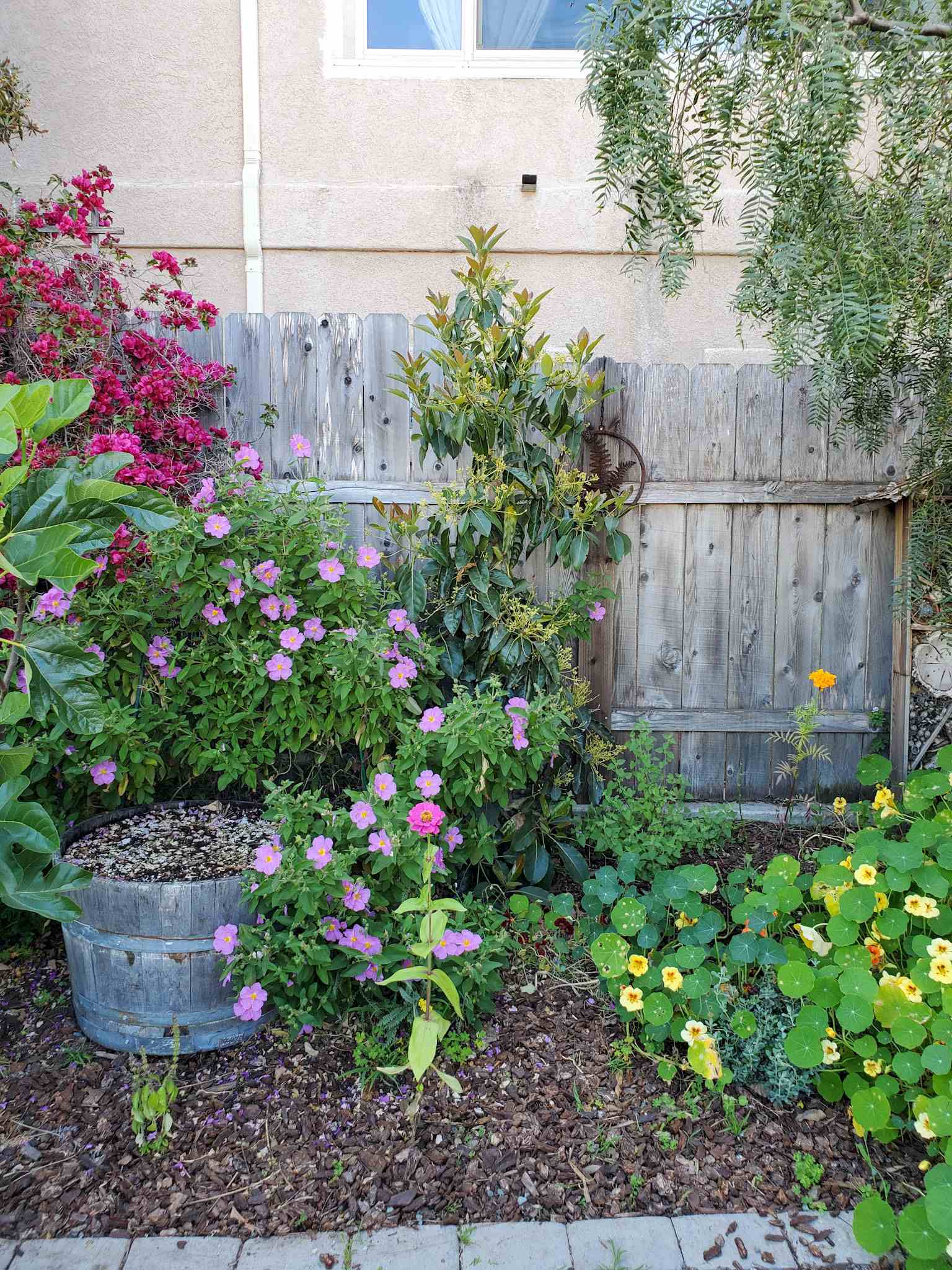
Avocado Tree Soil
Avocados grow most happily in moderately rich but well-draining soil. An ideal soil composition is sandy loam in the pH range of 6 to 6.5 (very slightly acidic). You’ll often hear me say that many plants enjoy well-draining soil, this is absolutely critical for avocado trees!
Avocados love water, but are not tolerant of soggy conditions and are prone to root rot. Therefore, if you have heavy clay soil in your yard, plant the avocado in an elevated mound to promote good drainage. The naturally shallow root system of avocado trees makes mounding a fairly effective solution to overcome clay or poorly-draining native soil. Or, build them a large wide raised bed (open on the bottom) to put over clay soil. Do not plant an avocado tree in a depression or area that water naturally collects. See more tips to plant avocado trees in the “planting” section to follow.
While sandy loam is the best for an avocado plant, they can successfully grow in a variety of soils. However, you’ll need to modify your watering practices to match your soil conditions accordingly.
Water
Water is arguably the most important avocado care factor to get right, and the one that influences their happiness and health the most!
The amount of supplemental water you’ll need to provide a growing avocado tree depends on the climate, soil, and age of the tree. If your soil is on the sandy side, you’ll need to water more. If your soil is on the clay end of the spectrum, you must water less to avoid soggy conditions. On average, a young tree will appreciate a good drink of water about twice per week, as their small and shallow root system will dry out more easily than a larger tree. As the tree becomes established (a year after planting), a deep watering once per week is typically sufficient – with the exception of those growing in the hottest climates.
Water thoroughly and deeply around the entire base and root system of the avocado tree. However, only water once the soil starts to dry out just slightly (but never completely). Manually probe and check the soil when in doubt. Do not water if the soil is still quite wet. During your rainy season, stop providing additional irrigation. We irrigate our avocado trees with drip irrigation, placing several bubblers or one micro-sprinkler around the base of each tree.
Mulch
Avocados grow a shallow wide root system and appreciate a deep layer of mulch over them. Mulch the base of the tree with several inches of coarse mulch, such as redwood bark and other natural organic material. Avoid mulching directly against the trunk of the tree itself – leave a nice open ring several inches around it. Allow the leaves that fall from the tree to stay and decompose in place.
In addition to bark mulch and fallen leaves, we like to add other organics around the base of our avocado tree. Plant material such as fava bean stalks, comfrey, yarrow, and borage leaves (all dynamic accumulators) are incredibly rich in nutrients. They make for excellent “chop and drop” or green mulch – and also serve as a natural fertilizer!
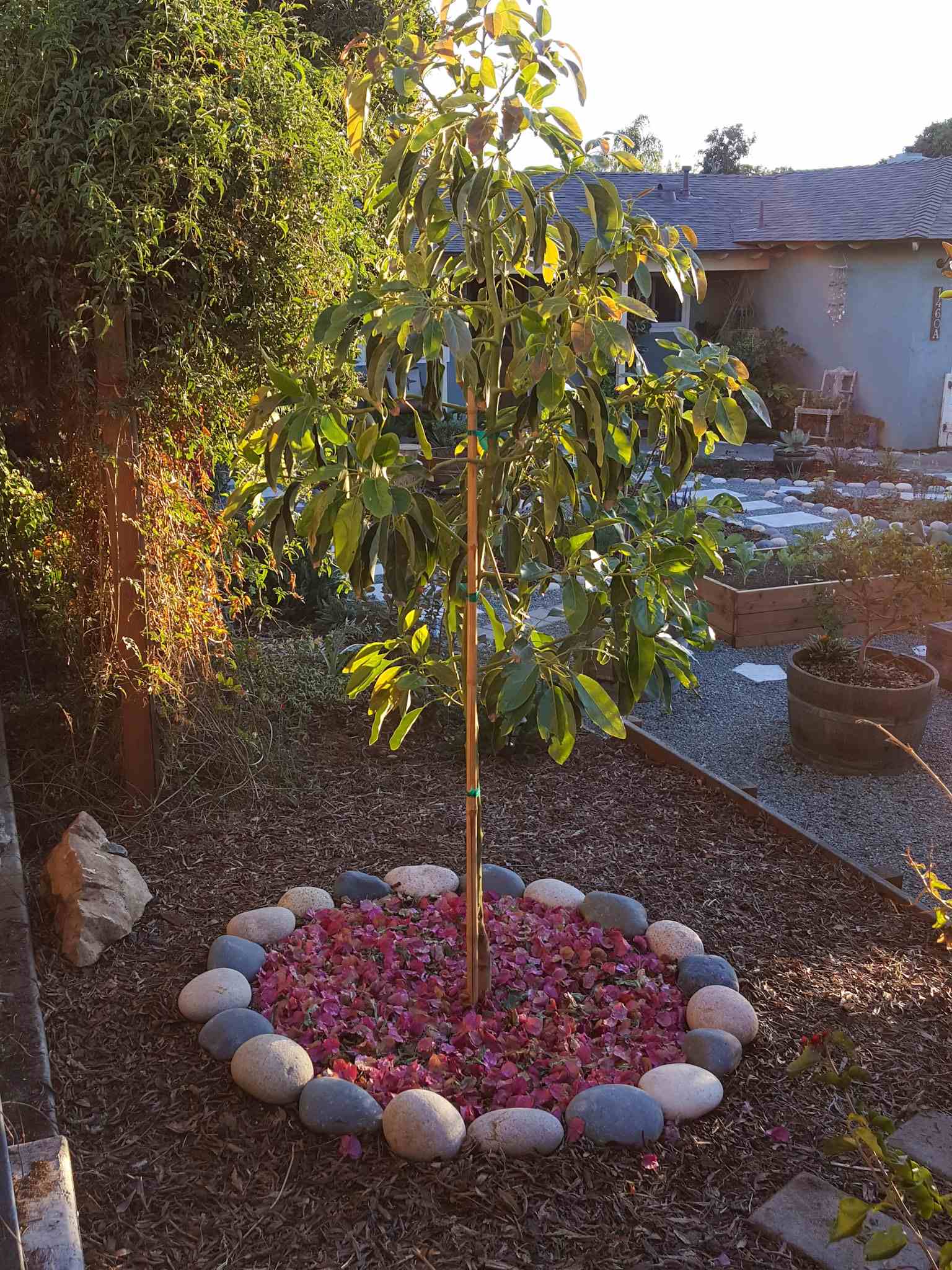
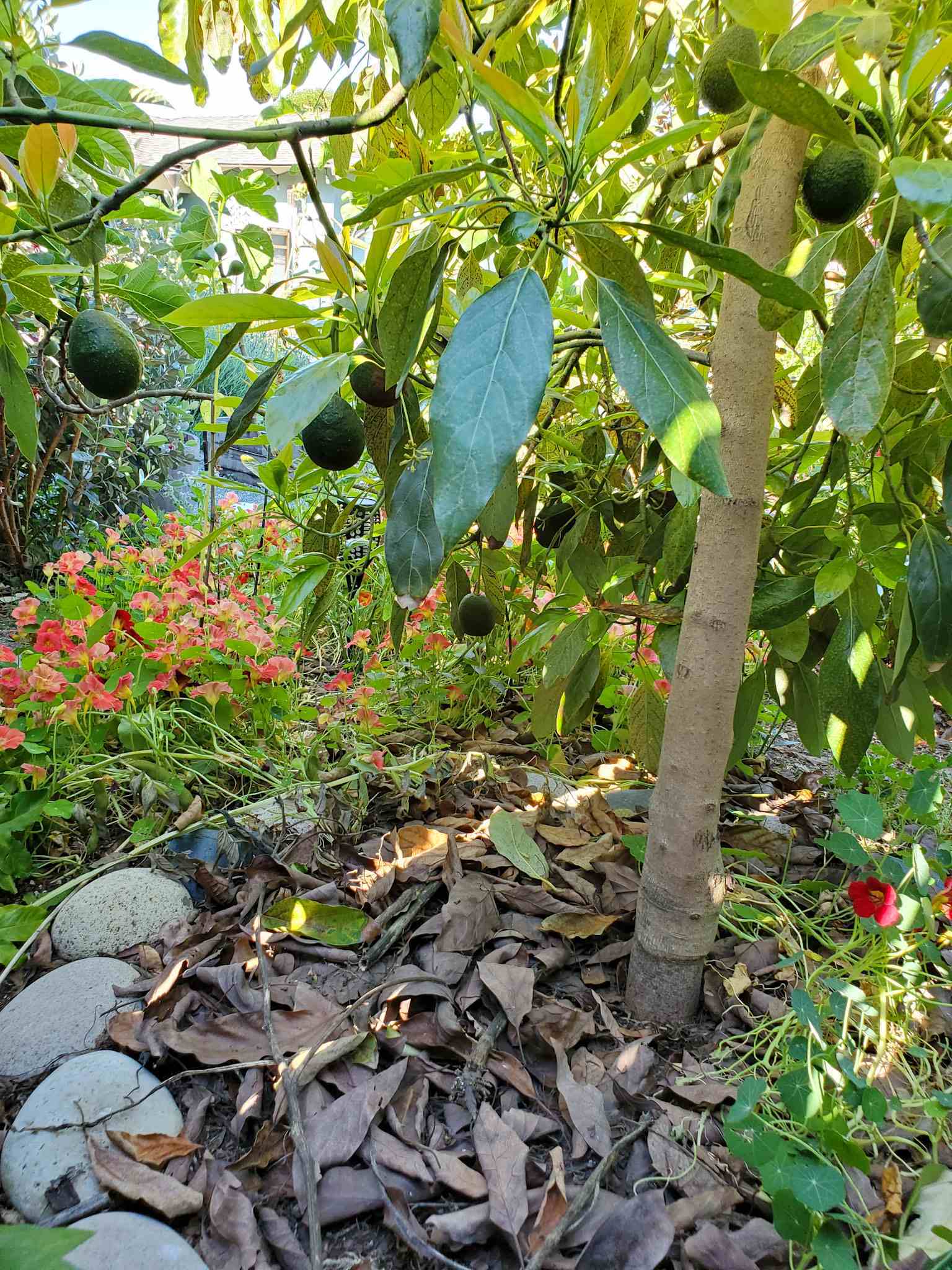
Avocado Plant Fertilizer
When you first plant your avocado tree, do not apply traditional NPK fertilizer. If anything, add a bit of aged compost or worm castings in the planting hole – or around the top of the tree as mulch. We also add some mild soil amendments like basalt rock dust and kelp meal for minerals, micronutrients, and general soil health. I don’ t consider those “fertilizers” as they have very little NPK value.
Once your avocado tree is established, provide a well-balanced slow-release fertilizer once or twice per year. We like to use this organic fruit tree fertilizer. Sprinkle it around the base of the tree as wide as the canopy extends. (Follow the application rate on the instructions.) In addition, we feed our avocado plants with homemade actively aerated compost tea once or twice per year. It provides some nutrients, but is especially good at introducing beneficial microbes to the soil! In turn, they help increase nutrient uptake, stress resistance, and promote overall soil and plant health.
HOW TO PLANT AN AVOCADO TREE
When it comes time to plant your new avocado tree, keep in mind all the likes and dislikes we’ve already gone over in this article – such as soil type, moisture, and microclimates. A quick summary is included below for easy reference. Otherwise, planting an avocado tree isn’t all that different from planting any other tree! Follow this guide for more detailed instructions and photos “How to Plant a Tree: Best Practices Success” (we planted our Fuerte avocado as the example for that article)
- Choose a location that is as sunny as possible, protected from the wind, and sheltered/warm in the winter.
- Follow the recommended spacing for the given variety. A common recommendation is 15 to 20 feet between avocado trees. We have small shrubs growing within 10 feet of ours.
- Some sources recommend to plant avocado trees in the spring, but we’ve successfully planted two in the fall here in California. I actually find it less maintenance at that time, as the mild rainy winter approaches and the tree needs less supplemental water. In contrast, spring planting is best in colder climates – so the baby tree can become established before winter.
- Dig a hole slightly larger than the root ball (but not much deeper), gently loosen the roots if they’ve become wound and bound, and place the root ball in the hole. Don’t yank on the trunk. The top of the root ball should be level with the surrounding soil or just above, but never below.
- Backfill the planting hole with native soil. Feel free to mix some well-aged compost or worm castings into the native soil, but don’t overdo it. The sooner the tree becomes accustomed to the native soil, the better it will do.
- If you have clay soil, plant your avocado tree on a slight mound. Dig a more shallow hole, and amend it with some potting soil or horticultural sand mixed with the native soil to increase drainage. Place the tree in the hole, but the root ball should be several inches to 1 to 2 feet above ground level. Mound well-draining soil around the exposed root ball and extend it 3 to 5 feet wide around.
- Do not add NPK fertilizer when you first plant your avocado tree. If anything, water the tree with a fresh aloe vera soil drench or dilute Vitamin B to help reduce transplant shock after planting. We add a small amount of compost, mild kelp meal, and basalt rock dust to the planting hole to help compensate for the poor quality of our native soil.
- Provide a support stake for the first year or two. Do not cover the planting area with landscape fabric. It will prevent the tree’s shallow roots from growing near the soil surface as they prefer to do.

Growing Avocado Trees in Containers
It is possible to grow avocado trees in a pot or other suitable large container. However, I want you to have realistic expectations. They will not bear as much fruit as those planted in the ground. Please also understand that you’ll need to work a little harder to keep your avocado tree happy, which goes for any containerized tree. To successfully grow an avocado in a pot, you must choose the right tree variety, soil, and also the right container.
As mentioned in the variety section above, “Little Cado” (aka Wurtz) is the only true dwarf variety of avocado tree. With its naturally compact size, it is an excellent choice for a container! Gwen is another naturally petite variety. Other avocado varieties may be grown in containers too, but will feel more stressed in confinement since it is going against their usual growth habits.
Choose as large of a container as possible. Aim for something equally wide as deep, rather than a tall narrow container. Again, avocado plants grow shallow roots so they’ll appreciate as much surface area as they can get. The container must have excellent drainage to avoid soggy conditions. A half wine barrel (with drainage holes added) or homemade wood box (like a mini raised bed) would work very well. Check out this article to see how we created mobile large tree containers with casters and dollies.
Fill the container with quality bagged soil made for container gardening, such as potting soil or a raised bed mix. From there, try to follow all the other care practices previously described, including mulching, shelter, fertilizing, and water guidance. You may need to water more frequently to achieve the desired soil moisture, and plan to fertilize twice per year.

What about growing avocados in a pot, but then bringing them inside over winter?
Bringing an Avocado Tree Indoors
You may be curious if you can grow an avocado tree indoors. Again, anything is possible if you put your mind to it and plan accordingly! To be frank, I wouldn’t suggest growing an avocado tree completely indoors year-round. Personally, I don’t consider the effort worth the reward, as it would bear little-to-no fruit. Yet if you want to try to grow an avocado tree in a mobile container that you can bring indoors during freezing conditions, that could be worth a shot!
Follow all the tips to grow an avocado plant in a container above. Then, wheel or haul her inside before the first winter frost. Keep the potted avocado tree near a sunny window, or provide supplemental grow lights while indoor. A unique challenge to overcome when growing avocados indoors is providing their preferred humidity level. When in doubt, assess the relative humidity in your home using a thermometer/humidity reader like this one. If the humidity is below 40%, either mist the tree routinely or use a humidifier nearby.
In order to become pollinated and set fruit, the avocado tree should be brought back outside while it is flowering if possible. Most avocado trees bloom in late winter to spring. The timing may get tricky if it is still freezing outside when your avocado tree goes into bloom while sheltered indoors.
A quick note about growing avocados in greenhouses
It is possible to grow avocados in a greenhouse. However, this is usually done in high-tech commercial greenhouses with very controlled conditions. The average hobby greenhouse will still subject the avocado tree to temperature swings much like outdoors, and may get undesirably hot. To learn more about using a hobby greenhouse, including options for temperature control, ventilation, and more, please see this article, I wrote all about it.

Avocado Tree Pests
Avocado trees are relatively fuss-free when it comes to pests and disease though *ish can happen. The most common avocado tree pests are tiny – mites and thrips. Because they’re so small, you will likely notice their damage (brown spotting on the leaves) before you see the insects themselves. Other fairly common avocado pests are small caterpillars that chew on the leaves. We’ve never had any issues with our avocado trees, and we have plenty of pests in our garden!
If you identify a mite or thrip infestation on your avocado tree, there are a number of organic methods to combat it. Try releasing predatory mites (known to target avocado Persea mites and thrips), or treating the leaves with a mild dilute insecticidal soap or neem oil solution. If you’re struggling with caterpillars, you could use an organic caterpillar killing spray, but please be careful to not overspray to non-target plants! Also, remove understory weeds or known pest host plants from the immediate planting area.
For a more thorough venture into avocado plant pest issues, please refer to this publication from the University of California Integrated Pest Management.
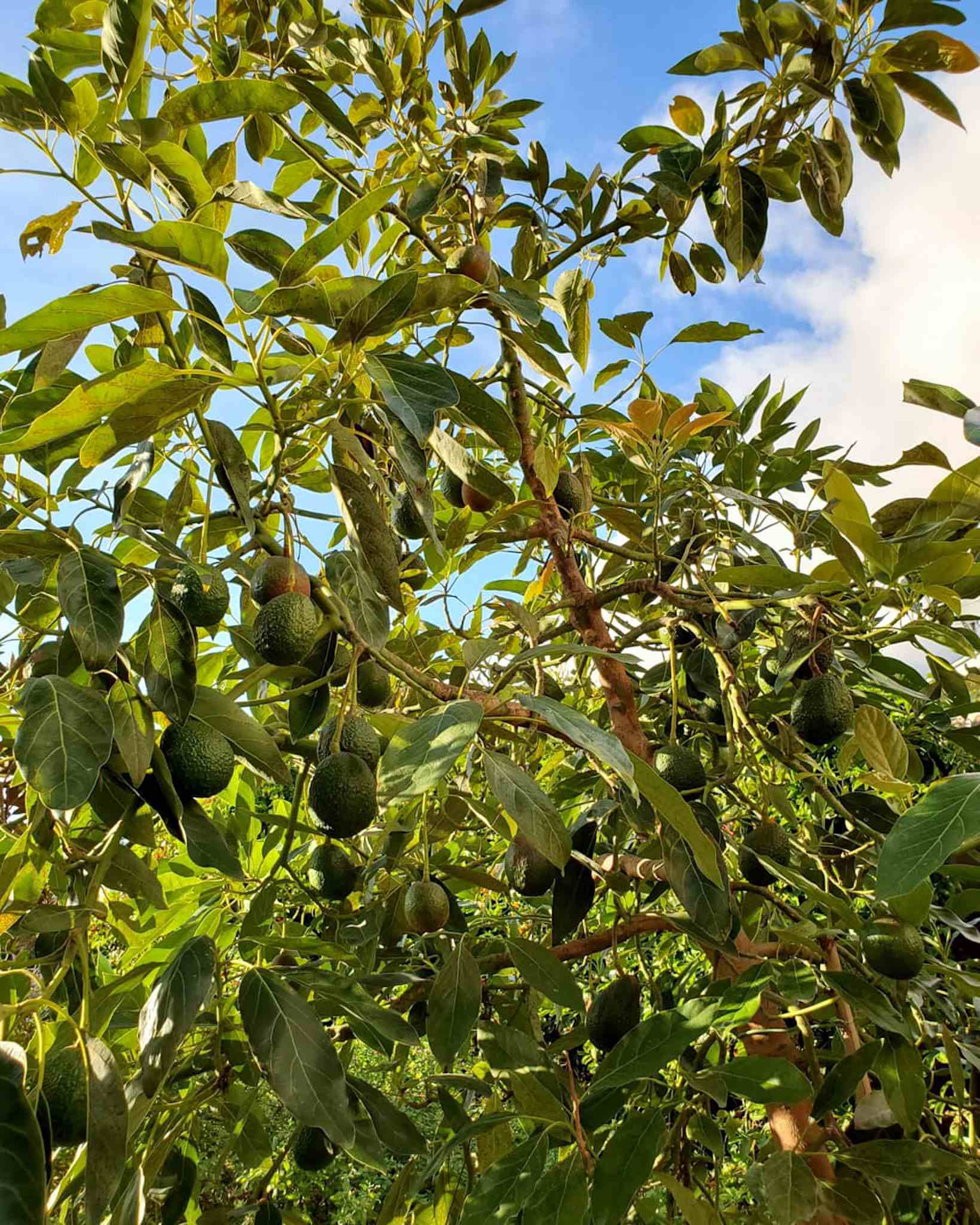
HARVESTING AVOCADOS
Unlike figs or other fruit, avocados do not soften on the tree. That is, unless they become grossly overripe and start falling from the tree! Instead, avocados should be harvested before they reach that point – and finish ripening off the tree. Harvest avocados when they reach the expected mature size and don’t appear to be getting any larger.
To assess if they’re ready, harvest just one of the largest avocados, let it ripen and test it out! Cut the avocado off the tree, leaving a nub of stem still attached. Allow it to sit at room temperature for 3 to 7 days and then give it a try once it seems ripe. A ripe avocado will “give” just slightly when gently squeezed with your fingertips. Not hard, not mushy.
If the flesh is soft and creamy, tastes good and not bitter, and doesn’t shrink and become leathery – they’re good to go! I like to eat my avocados when they become slightly soft but still have a bit of firmness. Personally, I can’t stand the flavor of an overripe avocado – unless they’re turned into guacamole with plenty of lime! Once avocados feel ripe at room temperature, move them into the refrigerator.
Fun fact:
I recently learned from this study that avocados ripen more nicely (with less drying and weight loss) in higher humidity. Our house is more dry than it is outside, so we are going to experiment with allowing the harvested fruit to ripen on our covered porch in the shade. I wonder how they’ll compare to those ripened on the kitchen counter? I will report back!

Avocado Harvest Time & Tree Storage Life
The time from flowering and fruit set to harvest depends on the variety of avocado. Check out this handy guide from the University of California to see the expected harvest time for your variety of avocado tree. Some may be ready for harvest within a few months after pollination, while others may not be ready until the following year. Yes, some avocados can stay on the tree for nearly a year! Again, this depends on the variety.
For example, Hass has a “storage life” on the tree for 8 months or longer once they reach mature size. Now in May 2020, we are currently harvesting avocados that began to develop on the tree in the spring to early summer of 2019. I love that we can pick just a few avos as needed and leave the rest on the tree, rather than being overwhelmed with dozens ripening all at once. On the other hand, some avocado varieties have a much shorter tree storage life. Bacon avocados must be harvested within about 2 months of reaching mature size.

Eating & Storing Fresh Avocados
Finally, it is time to EAT! Surely you don’t need too much help here. What are your favorite ways to eat fresh avo? In addition to making guac, putting it on homemade sourdough bread or sandwiches, we like to simply slice fresh avocado to top essentially any meal! With quinoa and sautéed veggies, egg dishes, salads, and even on top of chili. Pssst... If you need a killer chili recipe, check out our roasted sugar pie pumpkin 3-bean chili. It’s vegan!
A final tip I will share before signing off is about storing cut avocados. Assuming you don’t eat it all at once, that is! Once cut, the exposed avocado flesh can turn brown when exposed to air. It will also develop a firm layer of “skin” over it. To prevent that, we store cut avocados in these food-grade silicone reusable food storage bags. They stay fresh and maintain their beautiful color and texture – for days on end! Another option is to wrap them tightly in reusable beeswax wraps. Finally, adding a squeeze of lemon juice or drizzle of apple cider vinegar over the cut portion helps prevent it from browning.


And that is how you grow avocados!
Are you ready to grow some avocados of your own? I hope you found this article to be useful and interesting. Above all, I hope it helps make all your homegrown avo dreams come true! Please feel free to ask questions in the comments below, and spread the love by sharing this article. Stay tuned for a more in-depth review of different avocado plant varieties!








28 Comments
Nicholas Pomeroy
Hello,
I am curious if you think the soil you guys use for raised beds would also be appropiate for avocados? I am in the process of buying 2 Little Cado Avocado trees to plant in containers and would greatly appreciate your input!
Thanks,
Nicholas
Aaron (Mr. DeannaCat)
Hi Nicholas, that is usually what we do. Good soil with quality compost and you should be good to go. Mulch the top of your containers fairly well with compost or wood chips to keep the top of the soil moist, avocados have a lot of feeder/surface roots and are used to being underneath a good layer of mulch as they typically mulch themselves fairly well with time using their own leaves. Hope that helps and good luck!
Iinda
Moved in with my parents in Florida we have two avacado trees it’s now Nov. one tree is already been harvested the other largest tree has avacados for the first time they areuvh bigger and I was wondering since we have no clue the variety of you could maybe give me a idea when they will be ready. They are large and very green.
Aaron (Mr. DeannaCat)
Hi Linda, I would check around at your local nurseries or search online for avocados that grow in Florida. I am sure you will be able to find the unknown variety this way and then you will have an idea of when to harvest the fruit. Hope that helps and good luck!
Rick
Thanks for the great article! We’re in your neck of the woods in south SLO County too, and we just put a couple of avos in the ground last fall. I’ve been wondering if and when I should be pruning the young trees, and if so, what strategies to use. I know with other fruit trees, often you’ll want to prune away low-growing “sucker” branches, but I haven’t read yet what to do for best avo production.
What do you do with yours?
Thanks!
Aaron (Mr. DeannaCat)
Hello neighbor, letting them grow into a cone or pyramid shape is best to allow maximum light for the tree. We usually try and remove any low branches so the tree has a main trunk as opposed to a bush as it is easier to access in and around the tree. In time you can thin out areas of the canopy to allow light inside. For the most part so far, we have wanted our avocado trees to get big so the pruning has been minimal. Just picture what you want the tree to look like in the future and try and mimic that size and shape. An 8 to 10 foot tree is probably the best size to manage for harvesting fruit and general maintenance. Hope that is enough to get you started and good luck!
Jill Gidlund
Do you ever have trouble with rats eating the fruit on the tree?
Aaron (Mr. DeannaCat)
Hi Jill, we have yet to notice any of the fruit being eaten by rats or any other rodent although I know they can and will eat avocados. Maybe fruit that falls off the tree would be mores susceptible to rats? Anyway, I wouldn’t let the possibility of rodents getting an occasional fruit stop you from having an avocado tree. Good luck!
Sharon
Thank you for the interesting & informative article! We live in Maui & planted a dwarf avocado in September 2020. We look forward to our first fruit!
Parker
Terrific article. I’m in South Carlsbad, yard backs up to a canyon + slope that gets a lot of wind, full sun from say 12pm to sunset. I can plant up to six trees. Any recommendations on type? And could I plant a bigger size… say from a 24in box? Thanks!
Aaron (Mr. DeannaCat)
Hello Parker, sounds like you that should work out just fine. I am not sure of how much space you have to plant the trees, but assuming you have plenty of space, we do like to plant more mature trees (15 gallon containers) so they will produce fruit quicker. As far as variety, we would opt for Hass, Fuerte, Lamb Hass and Sir Prize with Hass being the one that we would plant more than one tree of. Hope that helps and good luck!